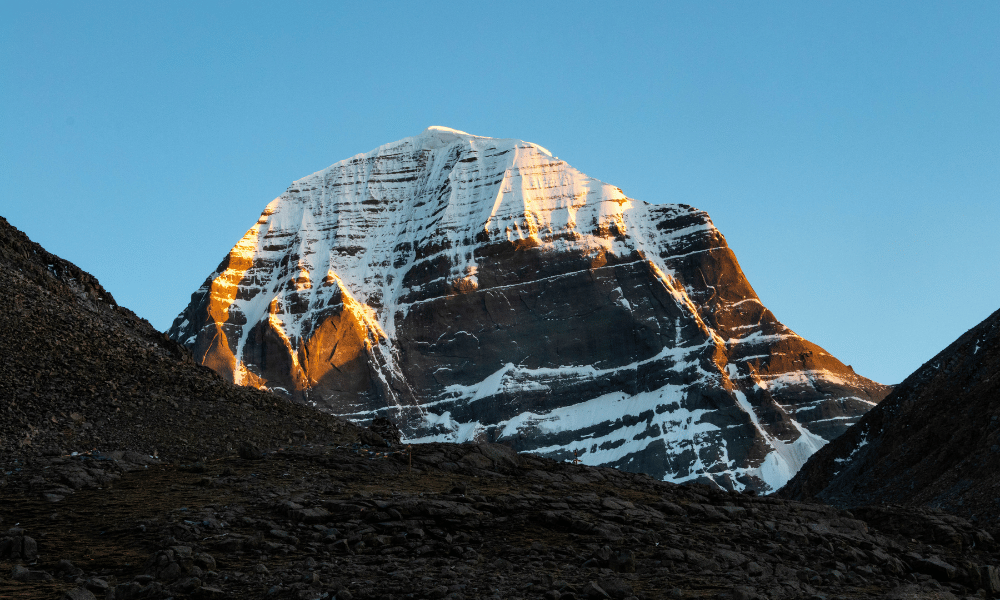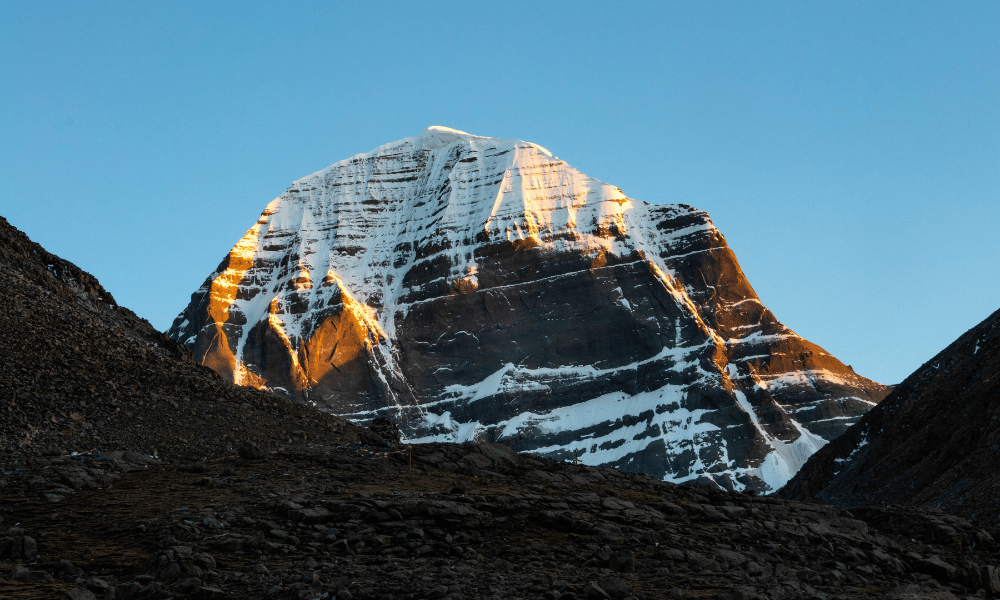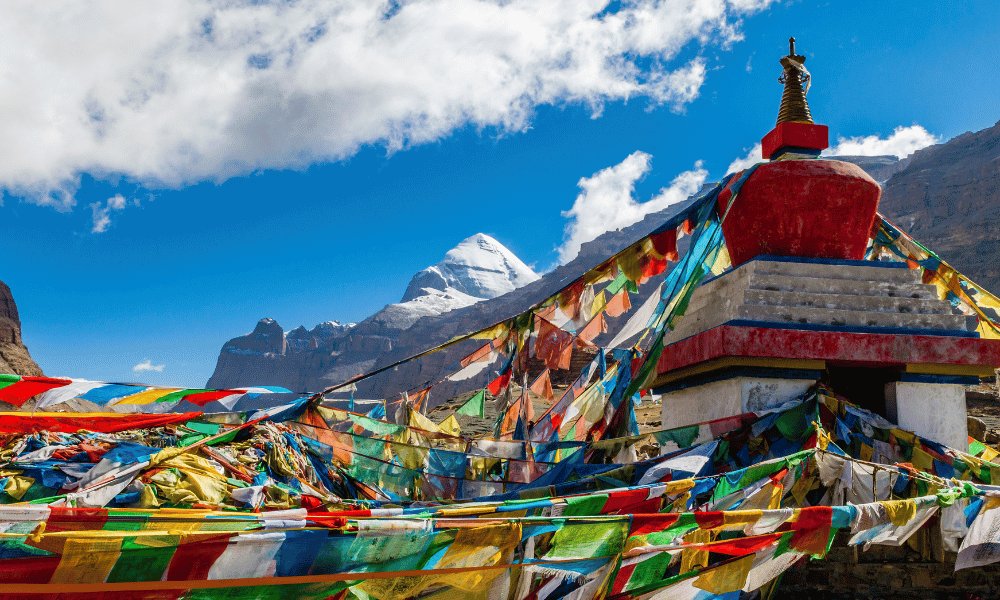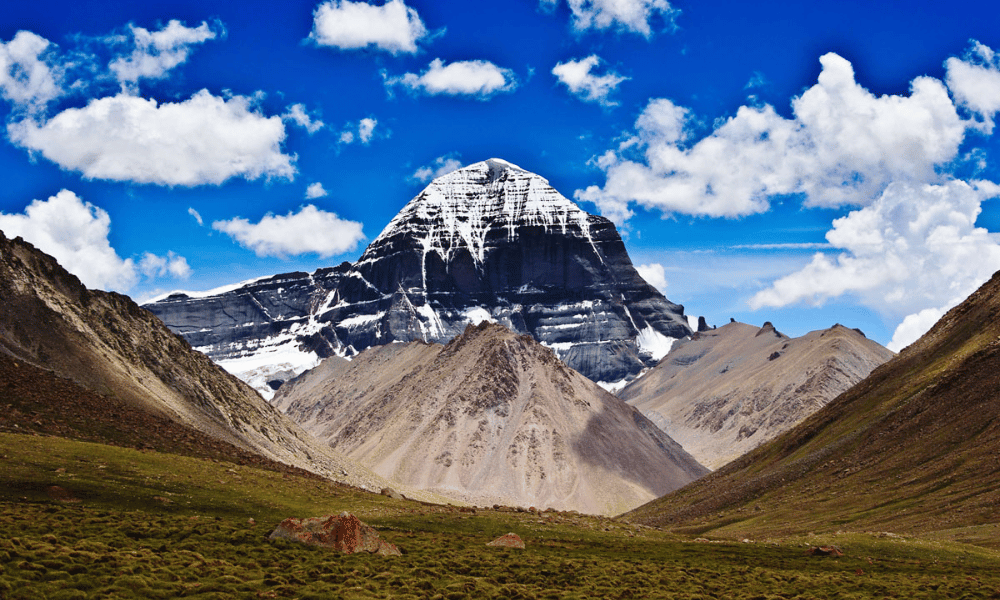The Himalayan range is a symbol of the faith and grandeur of the Earth. It is made up of mountains that touch the sky and rivers that echo the sounds of time. People often call it the "abode of the gods," and it is full of secrets, tales, and stories that have fascinated people for hundreds of years. As we start this trip of discovery, we start at Kailash Parvat, the canvas that holds the spiritual gem. Let's look at the majesty of the Himalayan range, which is where the mysterious Mount Kailash is.
The Majestic Canvas
The Himalayan range is made up of tall hills, green valleys, and complicated water systems. It is spread out over several countries. The range is a home of natural wonders. It has a lot of different kinds of plants and animals, and its glaciers are important sources of freshwater. Kailash Parvat, a unique mountain with deep spiritual and cultural importance, rises out of this background.
Formation of a Titan
About 50 million years ago, when the Indian and Eurasian tectonic plates crashed into each other, this beautiful mountain range was born. It is a place where natural processes change the landscape every day, showing how the Earth is always moving and changing.
A Cradle of Biodiversity
The diverse climatic zones of the Himalayan range foster a rich and varied ecosystem. From tropical forests to alpine meadows and glacial habitats, it is a sanctuary for countless species of flora and fauna, some of which are exclusive to this region. The Himalayas, therefore, stand as a vital ecological hub on the global map.
The Spiritual Epicenter
Beyond its geological and ecological wonders, the Himalayan range holds a deep spiritual resonance. Many peaks in this range are considered sacred in various religions, serving as abodes of deities and centers of pilgrimage. These mountains have witnessed the spiritual journeys of sages, yogis, and pilgrims, seeking wisdom, enlightenment, and connection with the divine.
Unveiling Kailash Parvat
As we traverse deeper into this pristine world, we will uncover the secrets of Kailash Parvat, a peak that has fascinated and beckoned seekers and adventurers for ages. A convergence point of spirituality, myth, and majesty, Kailash stands as a beacon of the divine, offering a journey that transcends the physical into the realm of the mystical.
Significance of Kailash Parvat
Kailash Parvat is important for more than just its geological structure. It is also important in faith, folklore, and traditional respect. That particular mountain in Tibet, which is part of the Transhimalaya, has been a source of fascination for people from all walks of life for hundreds of years. Let's look at the different things about Kailash Parvat that make it so attractive.
Spiritual Significance
Abode of the Divine: In Hindu tradition, Kailash Parvat is revered as the abode of Lord Shiva, a principal deity known for his aspects of destruction and regeneration. Accompanying him is his consort, Parvati, and their divine entourage.
Centre of the Universe: In many ancient texts and traditions, Kailash is referred to as the cosmic axis, the centre of the universe, where heaven meets earth, serving as a spiritual axis mundi.
Sacred Site for Multiple Religions: Apart from Hinduism, Kailash holds significant religious value in Buddhism, Jainism, and the Bon religion. In Buddhism, it is seen as the home of Demchok, a significant tantric deity. Jains consider it the site where their first Tirthankara attained Nirvana.
Geographical Significance
Natural Splendour: The peak is renowned for its natural beauty, characterized by its stunning symmetry and grandeur. Its four sheer walls and snow-capped peak create an awe-inspiring spectacle that has drawn adventurers and photographers from around the world.
Source of Mighty Rivers: Situated near Lake Manasarovar and Lake Rakshastal, Kailash serves as the source of some of Asia's longest rivers, including the Indus, Sutlej, Brahmaputra, and Karnali. This geographical aspect adds to its mystique, portraying it as a life-giving entity.
Cultural Significance
Pilgrimage Destination: For centuries, Kailash Parvat has been a significant pilgrimage destination, drawing people from all walks of life to undertake a journey that promises spiritual rejuvenation and perhaps, enlightenment.
Cultural Narratives and Legends: Numerous legends and narratives surround Kailash, making it a focal point in the cultural and religious discourse of several communities. These tales often weave stories of gods, goddesses, and ancient civilizations that resonate profoundly with believers and enthusiasts alike.
Scientific Curiosity
Unconquered Peak: Interestingly, Kailash is one of the few peaks in the Himalayas that remains unconquered. Its harsh terrains and the reverence it commands have kept mountaineers at bay, fostering a sense of respect and wonder for the mountain.
Unique Geological Features: The peak exhibits a unique geological structure, with four distinct faces made of different geological substances, arousing scientific curiosity and fostering numerous research endeavors.
Through its spiritual gravitas, breathtaking geographical features, and cultural narratives, Kailash Parvat stands as a beacon of mystery and reverence in the Himalayan range. As we delve deeper, we will unravel the layers of spirituality, natural wonder, and cultural richness that makes this peak a jewel in the crown of the majestic Himalayan range.
Objective of the Blog
In a world where technology and the quest of the real are becoming more important, there is a place where the spirit is drawn to the invisible, the mysterious, and the deep. Kailash Parvat stands out as a place of wonder and faith because of the stories that surround it, the beautiful scenery that surround it, and the deep spiritual resonance that runs through them all. As we explore this mysterious world, this blog aims to be a view into the deeper worlds of Kailash Parvat. This is a trip that goes beyond simple geographical study, touching on the spiritual heartbeat and cultural wealth that this revered peak represents. With this project, we hope to:
Unveil the Mysteries: Delve deep into the legends and stories that have enveloped Kailash Parvat for centuries, offering readers an insight into the mystical narratives that have made this peak a focal point of reverence and awe.
Spiritual Exploration: Traverse the spiritual pathways that many pilgrims have walked, exploring the philosophies and practices that define the spiritual significance of this mountain, offering readers a glimpse into the transformative potential of a pilgrimage to this sacred peak.
Geographical Grandeur: Showcase the geographical grandeur of Kailash Parvat, depicting its breathtaking landscapes, ecological diversity, and unique geological features that have captivated adventurers and nature enthusiasts alike.
Cultural Mosaic: Unravel the rich cultural tapestry that surrounds Kailash Parvat, offering readers an insight into the traditions, festivals, and community interactions that have fostered a vibrant cultural ecosystem in this region.
Interactive Engagement: Foster an interactive platform where readers can share their personal experiences, anecdotes, and reflections, cultivating a community of like-minded individuals who share a fascination for the mysteries and wonders of Kailash Parvat.
Resourceful Guide: Serve as a comprehensive resource for potential pilgrims and travelers, providing insightful tips, itinerary suggestions, and travel advisories that would assist in planning a successful and enriching journey to Kailash Parvat.
The Geographical Marvel
In this first installment of our journey to explore the enigmatic Kailash Parvat, we pivot our attention to its geographical aspects. A place where the heavens seemingly embrace the earth, Kailash is not just a physical entity but a living, breathing spectacle of nature. Let us embark on a virtual expedition to explore the geographical marvel that is Kailash Parvat, understanding its location, altitude, and topography that have fascinated geologists, adventurers, and nature enthusiasts alike.
Geographical Overview
Kailash Parvat, the jewel in the crown of the Trans Himalaya, presents itself as a geographical marvel, standing tall amidst a range known for its awe-inspiring beauty and natural diversity. Characterized by its distinct and symmetrical peak, Kailash Parvat offers a captivating sight, drawing individuals towards its mystique and grandeur. Its geographical attributes not only portray the magnificence of the Himalayan range but also speak volumes about the Earth’s dynamic geophysical processes that shaped this iconic peak.
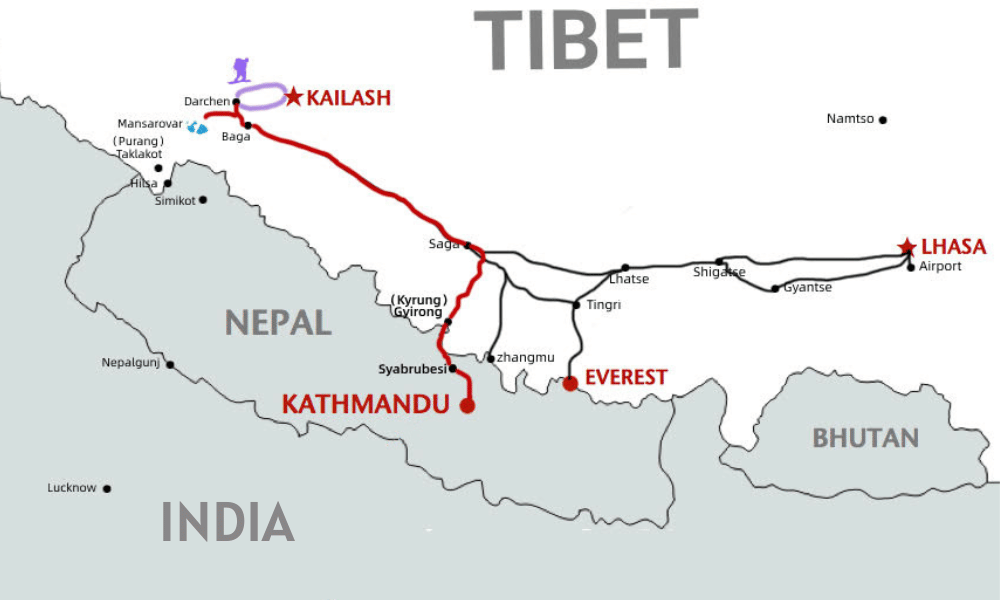
Location
Positioned in the Ngari Prefecture of Tibet, Kailash Parvat stands isolated, commanding a prominent place in the Trans Himalayan range. The peak is situated near two sacred lakes, Mansarovar and Rakshastal, which add to the spiritual and geographical significance of the region. The close proximity to the Nepal and Indian border makes it accessible for pilgrims and travelers from various routes, each providing a glimpse into the diverse landscapes that surround this revered peak.
Altitude
Rising majestically at an altitude of 6,638 meters (21,778 feet) above sea level, Kailash Parvat stands as a beacon of spirituality and natural splendor. Its towering height not only offers breathtaking views but also provides a vantage point where one can witness the confluence of cultures, spiritual philosophies, and the grandeur of the Himalayan range. The ascent towards the peak, though revered as a spiritual journey, is also a testament to the peak's imposing altitude, presenting challenges and awe-inspiring vistas in equal measure.
Topography
The topography of Kailash Parvat is characterized by its unique and symmetrical four-sided pyramid shape, with faces made up of different geological materials, each adding to its mystique. The slopes are steep, with rugged terrains that portray the Earth's raw and untamed beauty. Moreover, the region surrounding the peak is an interesting amalgamation of glaciers, rocky outcrops, and pristine river systems that originate from its vicinity. The topographical features not only paint a picture of natural beauty but also stand as a testament to the geological forces that sculpted this monumental peak over millions of years.
Climatic Conditions
Kailash Parvat is nestled in a region where the climate exhibits extremities, presenting a stark yet beautiful contrast to the lush landscapes and tranquil lakes that surround it. The climate in the region can be described as follows:
High-altitude Cold Desert Climate: The region experiences a high-altitude cold desert climate, characterized by harsh winters with heavy snowfall and freezing temperatures. This climatic condition results from its towering altitude and the presence of surrounding mountain ranges that block moist air masses.
Sparse Vegetation: Owing to its arid conditions, the region exhibits sparse vegetation, with hardy species adapted to the harsh climatic conditions dominating the landscape.
Variable Temperatures: The temperatures can vary drastically, with warm days and freezing nights. The daytime temperatures in summers can hover around 15-20°C, while nighttime temperatures can plummet to below zero, even during the summer months.
Best Time to Visit
Given the harsh climatic conditions, there exists a window of opportunity when the weather becomes relatively hospitable for visitors:
Late Spring to Early Autumn (May to September): This period marks the best time to visit Kailash Parvat. The temperatures are relatively moderate, and the roads are free from snow, facilitating easier access. This period also coincides with several religious festivals, providing an opportunity to witness the vibrant cultural festivities that take place in the region.
Avoid Winter Months: The winter months (October to April) are best avoided due to heavy snowfall, which makes the region inaccessible and the journey perilous.
Weather Peculiarities
Kailash Parvat's weather is known for its peculiarities, which include:
Sudden Weather Changes: The region is known for its sudden weather changes, where clear skies can quickly turn into snow storms or heavy rains, showcasing the unpredictable nature of high-altitude climates.
Intense Sunlight: Due to the thin atmosphere at high altitudes, the sunlight can be intense, with higher levels of UV radiation. Visitors are advised to take necessary precautions to protect themselves from potential sunburns and glare.
Starry Nights: The clear, unpolluted skies offer an unparalleled view of the starry nights, providing an opportunity for stargazers to witness the celestial beauty in all its glory.
Flora and Fauna
In the unforgiving terrains of Kailash, nature showcases its remarkable ability to adapt and thrive. The flora and fauna in the region have evolved unique adaptations to survive in the harsh climatic conditions, presenting a fascinating glimpse into the biodiversity of this high-altitude region.
Plant Species
Despite the challenging environmental conditions, a variety of plant species have made Kailash Parvat their home. The region's flora can be characterized as follows:
Alpine Flora: The region is home to a variety of alpine flora, with species that are well adapted to the harsh climatic conditions. During the brief summer season, the landscape comes alive with a burst of colors as alpine flowers bloom in full splendor.
Medicinal Plants: Interestingly, the region harbors several medicinal plants, which have been used in traditional Tibetan and Ayurvedic medicines for centuries. These plants, known for their potent medicinal properties, are a treasure trove for researchers and herbal practitioners.
Lichens and Mosses: Given the harsh conditions, lichens and mosses are commonly found, showcasing a symbiotic relationship between fungi and algae, a testimony to life's resilience in the extreme conditions.
Wildlife in the Region
The wildlife in the Kailash region has a mystical allure, with several species that have adapted to the harsh climates and rugged terrains. Here is an overview of the wildlife you can encounter in the region:
Mammals: The region is home to a variety of mammals, including the elusive snow leopard, blue sheep, Tibetan antelope, and wild yaks. These species have adapted to the high-altitude environment, showcasing remarkable resilience and survival skills.
Birds: The avian life in the region is also rich, with various bird species such as the Tibetan snowcock, bearded vulture, and the Himalayan griffon vulture gracing the skies. These bird species are well adapted to the high-altitude environment, with features that allow them to thrive in low-oxygen conditions.
Aquatic Life: The lakes surrounding Kailash Parvat are known to harbor a variety of aquatic life, including several species of fish that have adapted to the cold waters, providing a vital source of sustenance for the local communities and other wildlife.
A Hub of Spirituality
In this second chapter of our exploration of Kailash Parvat, we journey beyond the geographical grandeur to delve into the spiritual heartbeat of this revered mountain. An epicenter of faith and spirituality, Kailash Parvat transcends geographical boundaries to unite people of different faiths and philosophies. Its significance in various religions makes it a melting pot of diverse beliefs and rituals. Here, we explore the religious significance of Kailash Parvat in Hinduism, Buddhism, Jainism, and the indigenous Tibetan religion, Bon.
Religious Significance
Kailash Parvat is not just a geographical marvel but a spiritual powerhouse that resonates with deep religious significance. Revered as a sacred site by multiple religions, it stands as a testament to the confluence of faiths, where mythology, spirituality, and natural beauty intertwine to offer a rich tapestry of religious narratives and experiences.
In Hinduism
In the Hindu faith, Kailash Parvat holds a central position, revered as the abode of Lord Shiva and his consort Parvati. According to Hindu mythology:
-
Abode of Lord Shiva: Hindus believe that Lord Shiva, the god of destruction and regeneration, resides at the peak of Kailash Parvat, meditating and immersing in eternal bliss.
-
Manasarovar Lake: The nearby Manasarovar Lake is believed to have been created by Lord Brahma and is considered a personification of purity. Pilgrims seek to cleanse their sins by taking a dip in its holy waters.
-
Yatra and Circumambulation: Every year, thousands of Hindu pilgrims undertake the challenging Kailash Mansarovar Yatra, circumambulating the sacred mountain to seek blessings and attain salvation.
In Buddhism
In Buddhism, Kailash Parvat is equally significant, known as Mount Meru, the center of the universe in Buddhist cosmology:
-
Mount Meru: In Buddhism, Kailash is referred to as Mount Meru, believed to be the spiritual center of the universe, connecting the earthly realm with the divine.
-
Tantric Buddhism: It is a vital site in Vajrayana or Tantric Buddhism, where it is believed to be the home of the Buddha Demchok, who represents supreme bliss.
-
Pilgrimage Site: Buddhist pilgrims embark on a spiritual journey to Kailash, performing kora or circumambulation as a form of meditation and a way to accumulate merit.
In Jainism
In Jainism, Kailash Parvat is associated with spiritual liberation and enlightenment:
-
Ashtapada: Jains refer to the mountain as Ashtapada and believe it to be the place where the first Jain Tirthankara, Rishabhdeva, attained Nirvana or liberation.
-
Pilgrimage Site: Like other faiths, Jain pilgrims visit Kailash Parvat as a pilgrimage site to perform rituals that symbolize the attainment of Moksha or liberation from the cycle of rebirth.
In Bon (indigenous Tibetan religion)
Bon, the ancient Tibetan religion, also holds Kailash Parvat in high regard, attributing mystical and spiritual qualities to it:
-
Spiritual Center: In the Bon tradition, Kailash Parvat is known as the 'Nine-Stacked Swastika Mountain' and is considered a spiritual center where the sky, earth, and the underworld meet.
-
Shamans and Rituals: The region surrounding Kailash is believed to be a hub of mystical energies, where Bon shamans perform rituals to connect with the divine forces and seek spiritual enlightenment.
-
Cosmic Axis: According to Bon cosmology, the mountain acts as a cosmic axis, connecting the heavens, the earthly realm, and the underworld, serving as a spiritual bridge between various realms of existence.
Legends and Myths
As we travel around Kailash Parvat, we find ourselves in a world full of tales, myths, and folklore that give the towering mountain a mysterious look. In this part, we dive into the stories that show Kailash not only as a geographical wonder or a spiritual center, but also as a living thing with stories that span countries and ages. Let's look at some of the stories and myths that people often tell about this cosmic rock.
The Abode of Lord Shiva
One of the most pervasive and revered legends associated with Kailash Parvat is its identification as the heavenly abode of Lord Shiva, a primary deity in Hinduism. The tales woven around this belief are numerous and fascinating:
-
Eternal Meditation: It is believed that Lord Shiva sits in perpetual meditation atop Kailash Parvat. His meditative state is said to maintain the balance and harmony of the universe, nurturing the cycle of life, death, and rebirth.
-
Manasarovar Lake: Legends say that the sacred Manasarovar Lake was formed from the mind of Brahma, as a place where devotees can cleanse their sins, and it is situated near Kailash, enhancing the mountain's spiritual significance.
-
The Divine Dance: It is also believed that Lord Shiva indulges in the divine dance of creation, preservation, and destruction on this mountain, representing the cosmic cycles that govern the universe.
Stories Related to the Cosmic Mountain
Apart from being the abode of Lord Shiva, Kailash Parvat is enveloped with numerous other tales and myths that portray it as a cosmic mountain with universal significance:
-
Axis Mundi: In several religious beliefs, Kailash Parvat is perceived as the Axis Mundi, the world's center, connecting Earth with the heavens and the underworld, serving as a spiritual bridge between different realms of existence.
-
Jain Legends: In Jain mythology, Kailash is known as Ashtapada and is revered as the place where the first Jain Tirthankara, Rishabhdeva, attained moksha. His journey to enlightenment is embedded in many Jain scriptures and narratives.
-
Buddhist Legends: In Buddhist folklore, Kailash Parvat is considered Mount Meru, where Buddha Demchok resides. It is also the place where Milarepa, a famous Tibetan yogi and poet, demonstrated his spiritual prowess by winning a contest against a Bon sorcerer, symbolizing the victory of Buddhism over Bon in Tibet.
-
Bon Sacred Mountain: For the followers of Bon, Kailash Parvat is a sacred site where their founder, Tonpa Shenrab, descended from the heavens. The mountain is seen as a colossal mandala representing the spiritual structure of the universe.
-
Kailash and the Ramayana: The mountain also finds its mention in the epic, Ramayana, where it is described as the dwelling place of the divine birds, who are the messengers between the gods and humans.
The stories and legends surrounding Kailash Parvat offer a deep, introspective journey into the spiritual essence of the mountain. Through these narratives, one can glimpse the profound reverence and mythical stature accorded to Kailash across various cultures and religions. As we explore further, we will delve into the rich cultural tapestry that surrounds this mystical mountain, unearthing the traditions, rituals, and festivals that add vibrant hues to the spiritual canvas of Kailash Parvat.
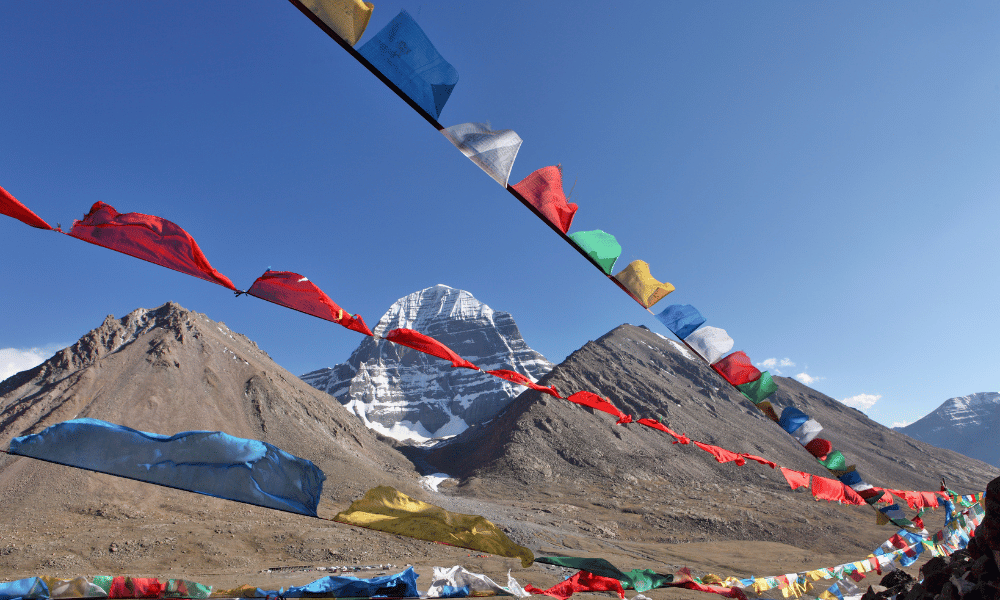
Pilgrimage
As we venture further into our exploration of Kailash Parvat, we now find ourselves amidst the sacred journey undertaken by countless pilgrims over centuries. The pilgrimage to this holy mountain, often considered a journey of a lifetime, transcends physical boundaries, guiding individuals towards a spiritual odyssey that promises enlightenment and purification. In this section, we will traverse the spiritual pathways of the Kailash Mansarovar Yatra and delve into the personal and transcendental experiences of the pilgrims who undertake this sacred journey.
The Kailash Mansarovar Yatra
The Kailash Mansarovar Yatra is more than a pilgrimage; it is a journey that epitomizes the quest for self-realization and spiritual awakening. Here we explore the various facets of this holy expedition:
-
Sacred Journey: Often referred to as a journey to the "center of the universe", the Yatra is a sacred journey that promises a confluence of divine energies and spiritual revelations.
-
Route and Duration: The pilgrimage encompasses a strenuous trek that spans several days, passing through some of the most scenic yet challenging terrains. Different routes can be taken to reach Kailash, each offering a unique perspective and experience.
-
Rituals and Customs: The Yatra is replete with various rituals and customs, including the ritualistic ‘parikrama’ or circumambulation of the mountain and a holy dip in the Mansarovar Lake, believed to purify the soul.
-
Spiritual Significance: The pilgrimage holds immense spiritual significance across several religions. It is believed that completing the Yatra can wash away the sins of a lifetime, providing a path to salvation.
Experiences of Pilgrims
As thousands embark on this sacred journey year after year, they come back with stories of transformation, awakening, and divine encounters. Here we share some of the profound experiences narrated by pilgrims:
-
Personal Transformation: Many pilgrims speak of a profound personal transformation, where the journey becomes a medium of self-discovery, fostering deeper introspection and spiritual awakening.
-
Divine Encounters: Several pilgrims recount experiences of divine encounters, where they felt the presence of a higher power guiding and blessing them during their journey.
-
Community and Unity: The Yatra fosters a strong sense of community and unity, where people from different walks of life come together in their shared quest for spiritual enlightenment.
-
Nature's Grandeur: Pilgrims often share their awe and wonder at the grandeur of nature, where the majestic landscapes become a backdrop for a deeper connection with the divine energies of the universe.
-
Physical and Mental Endurance: The Yatra is also a test of physical and mental endurance, where pilgrims find their inner strength and resilience tested, fostering a deeper understanding of their capabilities and spiritual potential.
The pilgrimage to Kailash Parvat is not merely a journey through the majestic mountains but a profound spiritual odyssey that promises transformation, enlightenment, and a deeper connection with the divine. As we conclude this section, we take with us the spiritual essence of the Kailash Mansarovar Yatra, a journey that represents the eternal quest for truth, purity, and spiritual liberation.
Related Read: Kailash Mansarovar Yatra by Helicopter | Kailash Mansarovar Yatra by Drive
The Mystical Journey
Navigating through the varied dimensions of Kailash Parvat, we find ourselves at the threshold of a transformative expedition known as the Kora. Considered one of the most sacred rituals associated with Kailash Parvat, the Kora or circumambulation is an integral part of the pilgrimage. In this section, we will explore the nuances of the outer Kora, providing a vivid description of the route and sharing personal experiences that encapsulate the mystical allure of this journey.
The Outer Kora (Circumambulation)
The outer Kora is not just a physical journey but a spiritual voyage that takes pilgrims through a series of sacred sites, each echoing with tales of divine energies and mystical occurrences. It is an immersive experience where pilgrims find themselves weaving through the tapestry of legends and spirituality that envelope the revered mountain.
-
Spiritual Significance: The outer Kora represents the pilgrimage's spiritual heart, a ritual of circumambulation that symbolizes the cycle of life, death, and rebirth. It is believed to purify the soul and pave the path towards enlightenment.
-
Key Sites: The outer Kora encompasses several key sites, including the Tarboche flagpole, the Yam Dwar, and various monasteries and chortens that are deeply rooted in the spiritual traditions of the region.
-
Physical Demands: While the journey is deeply spiritual, it is also physically demanding, with pilgrims navigating through rugged terrains, high altitudes, and harsh climatic conditions, embodying a journey of endurance and resilience.
Description of the Route
Embarking on the outer Kora offers pilgrims an opportunity to witness the raw beauty and spiritual magnetism of Kailash Parvat. Here, we offer a detailed description of the route:
-
Darchen: The journey typically begins at Darchen, a small settlement that serves as the starting point for the Kora. Pilgrims prepare themselves here, acclimatizing to the high altitude and absorbing the spiritual energies that pervade the area.
-
Yam Dwar: The next stop is Yam Dwar, the gateway of the gods. It is here that pilgrims offer prayers and seek blessings for a successful journey.
-
Dirapuk: From Yam Dwar, the trail leads to Dirapuk, offering spectacular views of the north face of Kailash. Pilgrims spend a night here, soaking in the divine energies that echo through the mountain ranges.
-
Dolma-La Pass: The journey then takes a challenging turn as pilgrims cross the Dolma-La Pass, the highest point in the Kora. It is a test of endurance, but also a point where many experience profound spiritual revelations.
-
Zutulpuk: The trail then descends to Zutulpuk, a place associated with the cave of miracles where the Tibetan saint Milarepa meditated. The final leg of the journey is a walk back to Darchen, completing the circumambulation.
Personal Experiences
The outer Kora is often described as a transformative journey, where personal narratives weave into the larger tapestry of spiritual experiences. Here, we share some personal experiences that resonate with the mystical allure of the Kora:
-
Spiritual Awakenings: Many pilgrims recount experiences of spiritual awakenings, where the journey becomes a mirror reflecting deeper truths and insights about life and existence.
-
Visions and Dreams: Some pilgrims share stories of vivid visions and dreams that occur during the Kora, often perceived as messages or guidance from the divine.
-
Community Bonds: The Kora fosters deep community bonds, where friendships are forged and stories are shared, creating a tapestry of human connections that transcend barriers of language and culture.
-
Healing Experiences: There are narratives of healing, where the Kora becomes a medium for physical and emotional healing, a place where individuals find peace and renewal amidst the sacred landscapes.
The mystical journey of the outer Kora is a dance of the divine and the earthly, a harmonious ballet where spirituality meets physicality, offering pilgrims an immersive experience that resonates with tales of enlightenment, transformations, and divine encounters. As we conclude this section, we carry forward the sacred energies and mystical allure of the Kora, stepping deeper into the vibrant cultural fabric that surrounds Kailash Parvat.
Inner Kora
Stepping deeper into the realms of Kailash Parvat, we find ourselves at the gateway to an even more sacred and profound journey - the Inner Kora. Often considered as the pinnacle of the spiritual pilgrimage to Kailash, the Inner Kora is a lesser trodden path that promises a deeper connection with the divine energies that reverberate through the holy mountain. In this section, we traverse the mystical pathways of the Inner Kora, unveiling its spiritual significance and providing a vivid description of the route that beckons the spiritually adept and seekers of deeper truths.
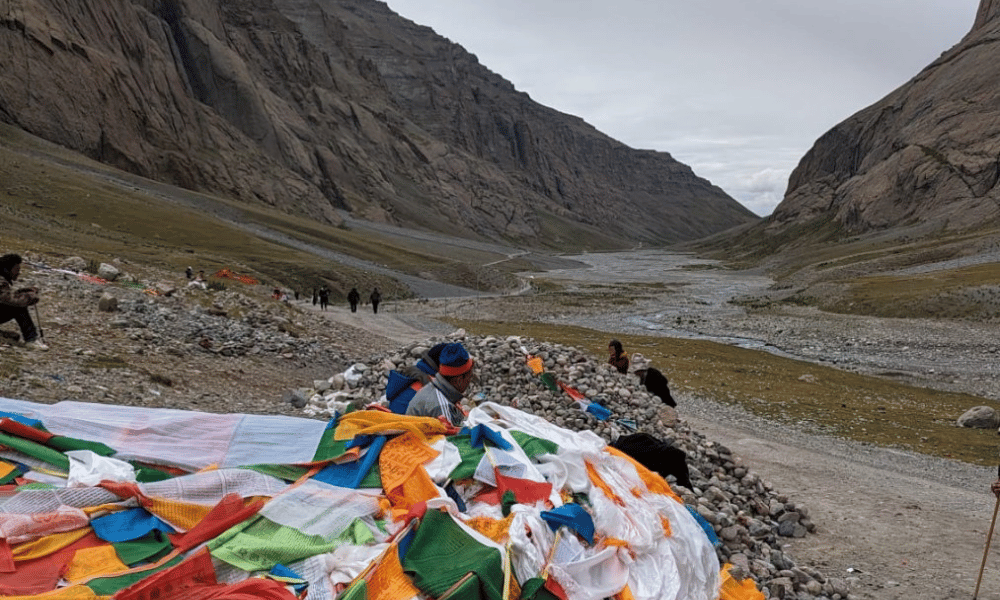
Inner Kora: Spiritual Significance
The Inner Kora is not just a pilgrimage route but a transcendent journey that invites pilgrims to delve deeper into their spiritual selves, facilitating a communion with the divine energies that reside within and around Kailash Parvat.
-
A Journey Within: More than a physical journey, the Inner Kora is perceived as a journey within, guiding individuals towards deeper layers of self-realization and spiritual enlightenment.
-
Gateway to the Divine: It is often considered a gateway to the divine, a sacred pathway where pilgrims can experience direct communion with the celestial energies that resonate through Kailash.
-
Purification and Transformation: The Inner Kora is believed to facilitate a process of purification and transformation, helping individuals shed their karmic burdens and emerge with renewed spiritual vitality.
-
Realm of Mystical Experiences: This path is synonymous with mystical experiences, where pilgrims recount visions, divine encounters, and profound realizations that redefine their perception of reality and existence.
Description of the Route
The Inner Kora, a less trodden but immensely sacred route, promises a journey that is both physically demanding and spiritually rewarding. Here we detail the key segments and experiences that define this path:
-
Serlung Monastery: The journey generally commences at the Serlung Monastery, a point where pilgrims seek blessings and prepare themselves for the sacred expedition ahead.
-
Sapta Rishi Caves: The route then leads to the Sapta Rishi Caves, believed to be the meditation abode of the seven celestial sages. It is a place where time seems to stand still, echoing with the meditative energies of the ancient seers.
-
Nandi Parvat: The next segment of the journey involves circumambulating the Nandi Parvat, a sacred peak that is believed to be the celestial bull of Lord Shiva. This part of the journey offers breathtaking views of the south face of Mount Kailash.
-
Atmalingam: Further ahead, pilgrims reach the Atmalingam, a highly revered site where it is believed that the energies of Lord Shiva are palpably present. Pilgrims meditate here, absorbing the divine vibrations that permeate the surroundings.
-
Khandosanglam: The route then descends to Khandosanglam, a confluence of spiritual energies and a place where pilgrims can witness a panorama of sacred sites and natural wonders that embody the spiritual essence of Kailash.
The Inner Kora is a journey beyond the physical, a sacred pathway that leads pilgrims into the mystical heart of Kailash Parvat. It is a voyage that promises spiritual transcendence, a deeper connection with the divine, and an unveiling of inner truths that guide individuals towards enlightenment and spiritual awakening
Mystical Experiences
As we traverse deeper into the spiritual terrain of Kailash Parvat, we encounter a realm that thrives on stories woven from the mystical experiences of pilgrims and seekers over centuries. Kailash, often referred to as the axis mundi, the center of the world, not only magnetizes people through its sheer geographical grandeur but also through the enigmatic experiences that it bestows upon its visitors. This section seeks to weave the rich tapestry of mystical experiences, narrating tales of spiritual epiphanies while also providing a glimpse into the scientific perspectives that attempt to decipher the mysteries of this sacred mountain.
Tales of Mystical Experiences
Kailash Parvat, a nexus of divine energies, has been the stage for countless mystical experiences. Here, we narrate a few tales that reverberate through time, echoing the mystical allure of Kailash:
-
Visions of the Divine: Many pilgrims recount experiences where they have had visions of the divine, witnessing celestial beings or receiving divine messages during their pilgrimage.
-
Healing Energies: Tales abound of the healing energies of Kailash, where pilgrims have experienced physical or emotional healing, often described as a purification of the soul.
-
Synchronous Events: Numerous accounts narrate synchronous events, where a series of occurrences seem to align perfectly, guiding pilgrims on their journey and facilitating profound spiritual experiences.
-
Time Dilation: Some pilgrims speak of experiences where time seems to dilate, allowing them to perceive realms beyond the physical, often leading to profound realizations and spiritual awakenings.
Scientific Perspectives
Parallel to the realm of mystical tales, the scientific community has also ventured into exploring the mysteries of Kailash Parvat. Here, we delve into some of the scientific perspectives that attempt to unravel the enigmas of Kailash:
-
Unique Geological Formation: Researchers have pointed to the unique geological formations of Kailash, which contribute to its magnetic allure. The mountain's structure and composition may play a role in the various mystical experiences recounted by pilgrims.
-
High Altitude Effects: The high altitude of the region, coupled with its pristine environment, might influence the psychological and physiological experiences of the pilgrims, potentially facilitating deeper meditative and introspective states.
-
Geomagnetic Forces: Some theories suggest that Kailash is a hub of geomagnetic forces, which might interact with the human biofield, leading to altered states of consciousness and mystical experiences.
-
Study of Local Flora and Fauna: The scientific community has also taken an interest in studying the diverse flora and fauna of the region, which seem to thrive in the high-energy environment of Kailash, possibly hinting at the mountain's unique energetic properties.
The narrative surrounding Kailash Parvat is a rich amalgamation of mystical tales and scientific investigations, creating a tapestry that resonates with the awe-inspiring and enigmatic nature of this sacred mountain. As we explore these varied perspectives, we find ourselves at the crossroads of science and spirituality, where empirical investigations meet transcendental experiences, offering a multifaceted view of the mysteries that encompass Kailash Parvat.
The Cultural Spectrum
Venturing beyond the mystical pathways and the celestial whispers that resonate in the mountains, we find ourselves amidst a vibrant tapestry of cultures, traditions, and festivals that encompass Kailash Parvat. This section paints a vivid picture of the local culture that thrives in the shadow of the sacred mountain, illustrating the rich traditions and festivities that echo the spirit and reverence that people hold for Kailash Parvat.
Local Culture
The communities residing around Kailash Parvat are the guardians of ancient traditions and wisdom. Their lives are intricately woven with the rhythms of the mountain, reflecting a symbiotic relationship that embodies reverence, spirituality, and harmony with nature. Here, we delve into the facets of the local culture:
Lifestyle and Livelihood: A glimpse into the daily lives of the local population reveals a lifestyle steeped in simplicity and harmony with nature. The livelihoods of many are linked with the pilgrimages, as they offer services as guides, porters, or run lodges and eateries.
Art and Craftsmanship: The region is renowned for its rich tradition of art and craftsmanship, where local artisans create intricate thangkas, statues, and handicrafts that echo the spiritual ethos of the region.
Music and Dance: Music and dance form an integral part of the local culture, with traditional performances narrating tales of gods, goddesses, and the mystical narratives associated with Kailash Parvat.
Traditions
The traditions associated with Kailash Parvat are rich and diverse, encompassing rituals, ceremonies, and practices that have been passed down through generations. Here, we explore some of these traditions:
Rituals and Ceremonies: The region is home to a plethora of rituals and ceremonies that are performed to honor the sacred energies of Kailash. These may include offerings, prayer ceremonies, and rituals conducted during specific astronomical events.
Sacred Narratives: The local population cherishes and passes down sacred narratives associated with Kailash, weaving a rich tapestry of legends and myths that resonate with the spiritual significance of the mountain.
Yoga and Meditation: The traditions of yoga and meditation are deeply rooted in the region, with many embarking on spiritual retreats to immerse themselves in practices that facilitate inner transformation and enlightenment.
Festivals
The festivals around Kailash Parvat are vibrant and colorful events that celebrate the spiritual, cultural, and natural aspects of the region. Some of the prominent festivals are:
Saga Dawa Festival: Celebrated by the Buddhist community, this festival marks the birth, enlightenment, and death of Buddha. It is a time for reflection, prayer, and acts of generosity.
Yak Festival: This festival celebrates the majestic Yak, an animal that holds significant importance in the region. It is marked by colorful parades, traditional music, and dance performances.
Kailash Kora Festival: Coinciding with the pilgrimage season, this festival witnesses thousands of pilgrims and visitors congregating to circumambulate Kailash, fostering a sense of unity and spiritual camaraderie.
Through the vibrant tapestry of local culture, traditions, and festivals, we witness a living testament to the spiritual resonance of Kailash Parvat. As we immerse ourselves in the rich cultural spectrum that surrounds the sacred mountain, we come to appreciate the harmonious blend of spirituality and cultural heritage that defines this region.
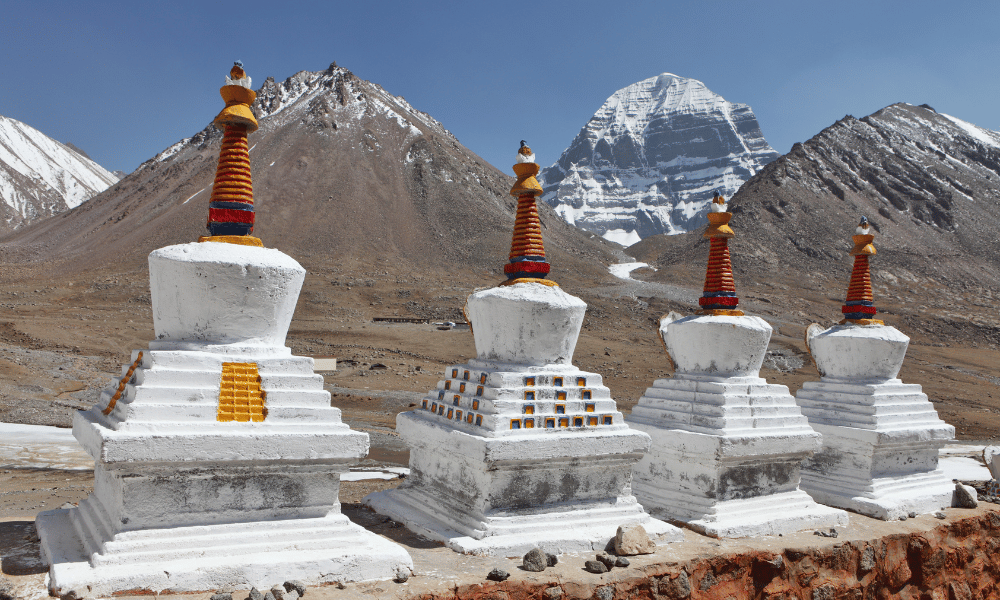
Art and Architecture
As we venture further into the vibrant panorama surrounding Kailash Parvat, we cannot overlook the intricate art and exquisite architecture that adorn this sacred landscape. In this section, we unveil the beauty and grandeur of the monasteries, ancient scriptures, and artefacts that bear testimony to the rich cultural and spiritual heritage that has flourished in the shadow of Kailash for centuries.
The region surrounding Kailash Parvat is a vibrant canvas of art and architecture that captures the essence of spirituality and the rich cultural lineage of the area. Let us delve deeper into this magnificent realm:
Thangka Paintings: This region is famous for its intricate Thangka paintings, a unique art form that uses natural pigments to create vivid representations of deities, mandalas, and narratives from the scriptures.
Sculptures and Statues: The local artisans are adept in sculpting statues depicting various deities and figures from the mythology, often carved from stones, woods or cast in metals, bearing intricate details and exemplary craftsmanship.
Architectural Marvels: The area hosts several architectural marvels, including stupas, monasteries, and shrines, that exhibit a seamless blend of various architectural styles representing the confluence of diverse cultures in the region.
Monasteries
The sacred grounds near Kailash Parvat house several ancient monasteries that stand as the pillars of spiritual learning and meditation. These sanctuaries resonate with the divine energies of the mountain:
Tarchen Monastery: Often considered as the gateway to the sacred pilgrimage, this monastery serves as a spiritual hub where pilgrims gather to commence their journey around Kailash.
Serlung Monastery: Nestled amidst the serene landscapes, this monastery offers breathtaking views of Kailash and serves as a starting point for the inner kora.
Zutrulpuk Monastery: Known for its beautiful murals and the cave of miracles associated with the Tibetan yogi Milarepa, this monastery is a significant stop during the outer kora.
Ancient Scriptures and Artefacts
Kailash Parvat and its surrounding regions have been a repository of ancient scriptures and artefacts, which bear witness to the rich spiritual heritage of the area:
Sacred Texts: The region houses a treasure trove of sacred texts and scriptures that narrate the myths, legends, and philosophies associated with Kailash, offering insights into its spiritual significance across various traditions.
Relics and Artefacts: Pilgrims and visitors can witness a diverse range of artefacts, including ritual implements, statues, and relics, which bear the imprints of the rich cultural and spiritual lineage of the region.
Rock Inscriptions and Murals: The landscapes are adorned with rock inscriptions, carvings, and murals that narrate the tales of deities, sages, and spiritual seekers who have graced the sacred grounds of Kailash across ages.
The art and architecture surrounding Kailash Parvat weave a rich tapestry that embodies the spiritual, cultural, and artistic essence of this sacred region. From the vibrant Thangka paintings to the serenity of the ancient monasteries and the wisdom enshrined in ancient scriptures, every element invites individuals to delve deeper into the multifaceted beauty and grandeur of Kailash.
Community Interaction
As we approach the end of our journey, it becomes imperative to engage deeply with the communities that form the heartbeat of the Kailash region. The vibrant life stories, the hospitable hearts, and the tales that have been passed down through generations find a home within the local populace. This section takes readers through the enriching experience of community interaction, where the spirit of Kailash reverberates through the smiles, the warmth, and the wisdom of the local inhabitants.
Experiencing the Local Hospitality
An excursion to Kailash is incomplete without immersing oneself in the warmth and hospitality of the local community. Their welcoming nature, grounded living, and the seamless blend of spirituality into daily life offer a fresh perspective to every visitor:
Homestays: Experience the heartwarming hospitality through the local homestays, where visitors are welcomed as part of the family, offering a glimpse into the simple yet fulfilling lifestyles.
Community Feasts: Participate in community feasts where local cuisines are served with love, offering a culinary journey that combines tradition with the rich flavors of the region.
Folklore Evenings: Engage in mesmerizing evenings where locals narrate folklores, share ancient tales, and perform traditional music and dances that echo the spirit of Kailash.
Conversations with the Locals
Conversations with the locals offer an enriching insight into the living traditions, the spiritual ethos, and the rich cultural tapestry that is woven around Kailash:
Elders' Wisdom: Spend time with the elders of the community who are the custodians of ancient wisdom, sharing stories and experiences that offer a deeper understanding of the spiritual significance of Kailash.
Spiritual Narratives: Engage with the locals who narrate the spiritual narratives associated with Kailash, offering a living testimony to the legends and myths that surround the sacred mountain.
Personal Testimonies: Listen to personal testimonies of mystical experiences and spiritual transformations from locals who have grown up in the shadow of Kailash, echoing the mountain's transformative energies.
Community interaction stands as a significant pillar in the exploration of Kailash Parvat, offering a genuine and heartfelt glimpse into the heart of this sacred region. Through the hospitality and narratives shared by the local community, visitors are welcomed into a vibrant tapestry that embodies the spirit of unity, reverence, and cultural richness.
Useful Read: What is Kailash Mansarovar Yatra | Kailash Mansarovar Yatra for NRI
Traveling to Kailash Parvat
Before embarking on a journey to Kailash Parvat, one needs to be equipped with a comprehensive knowledge about the necessary preparations. The journey to this sacred peak is not just spiritual but also a physical endeavor that demands meticulous planning and preparation. In this section, we guide prospective travelers through the essential steps and prerequisites for a safe and fulfilling pilgrimage to Kailash Parvat.
Travel Preparations
A journey to the divine Kailash Parvat necessitates considerable preparations to ensure a comfortable and rewarding experience. Here, we outline the critical aspects to consider:
-
Route Planning: Depending on your place of origin, decide on the most feasible route to reach Kailash Parvat. Research well on the available options and the amenities on the way.
-
Accommodation and Logistics: Book your accommodations well in advance and ensure that you have sorted the logistics including transportation, food, and guided tours if preferred.
-
Packing Essentials: Make a checklist of all the essential items to carry, including warm clothing, medicines, and necessary gear for the trek.
Necessary Documents
Ensuring that you have all the necessary documents in place is vital for a hassle-free journey. Here, we detail the essential documents that you will require:
-
Passport and Visa: Ensure that your passport is valid for at least six months from the date of travel. Secure the necessary visas or permits for entry into Tibet or Nepal, depending on your chosen route.
-
Travel Insurance: Considering the remote location and the rigorous nature of the trek, securing a comprehensive travel insurance policy is advisable.
-
Permits and NOCs: Depending on your nationality and the route chosen, you may require special permits and No Objection Certificates (NOCs) to undertake the Kailash Mansarovar Yatra.
Health and Fitness Requirements
Embarking on a journey to Kailash Parvat demands a good level of physical fitness and well-being. Below, we outline the health and fitness requirements that one should consider:
-
Medical Check-up: Undergo a thorough medical check-up to ascertain your fitness level. Discuss your travel plans with your doctor and seek advice on necessary vaccinations and medications.
-
Physical Fitness: Engage in regular physical training to build stamina and endurance, as the trek involves walking long distances at high altitudes.
-
Acclimatization: Once at the base, spend sufficient time acclimatizing to the high-altitude conditions to prevent altitude sickness.
As we round up this section, we trust that prospective travelers are now equipped with the knowledge and insights needed to plan a successful journey to Kailash Parvat. The road to Kailash is as much about physical preparation as it is about spiritual readiness. Ensuring that you are well-prepared can help you fully immerse in the mystical and transformative experiences that await at the sacred mountain.
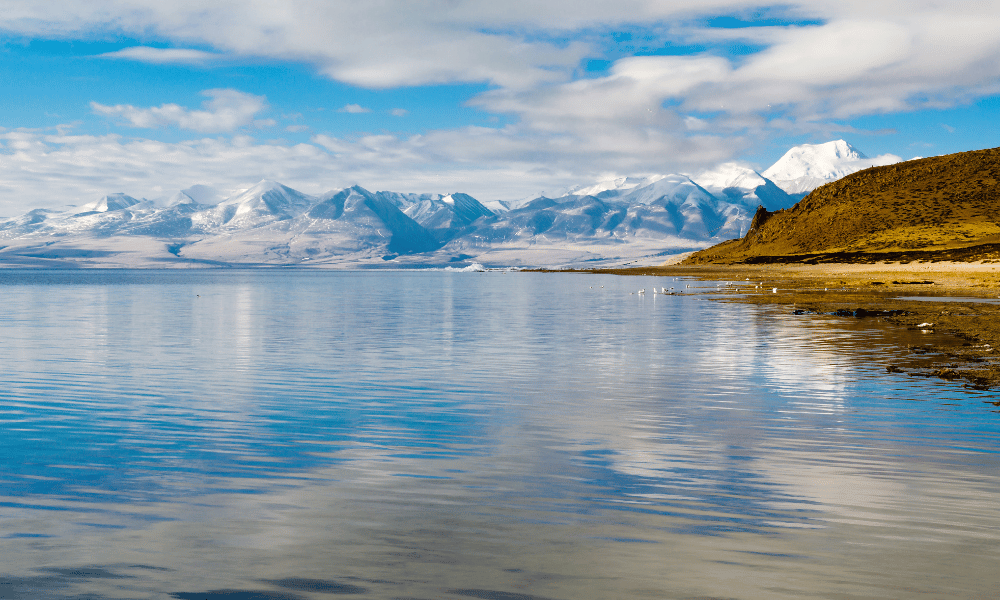
Journey Itinerary
Planning your itinerary is a critical step to ensure a smooth and fulfilling journey to Kailash Parvat. In this segment, we present a detailed framework that outlines the potential route details and staying options, facilitating a well-organized trip that allows you to immerse yourself in the magnificence that Kailash has to offer.
Route Details
Arrival at Kathmandu or Lhasa: Depending on your chosen route, you would either arrive in Kathmandu, Nepal or Lhasa, Tibet. Take some time to acclimatize and explore the local attractions before proceeding further.
Journey to Saga/ Nyalam: From Kathmandu, journey towards Saga (if traveling via Tibet) or Nyalam, taking in the breathtaking views of the Himalayan range en route. If traveling via Lhasa, explore the mystical city before proceeding towards Saga.
Reaching Lake Mansarovar: The next leg of the journey takes you to the tranquil Lake Mansarovar, where you can engage in rituals or simply soak in the serene surroundings.
Trek to Mount Kailash: Proceed to Darchen, the base camp of Mount Kailash, from where you embark on the revered Kailash Kora, a pilgrimage trek that encompasses both the outer and inner circumambulation routes.
Staying Options
While journeying towards Kailash Parvat, there are several staying options to choose from, depending on your preferences and the chosen route:
Guest Houses and Lodges: Throughout the route, there are various guest houses and lodges that offer basic amenities and a comfortable stay.
Homestays: In some areas, you may find local homestays, providing a more intimate experience with the local culture and hospitality.
Camping: For the adventurous souls, camping under the starlit sky can be a thrilling option, especially during the trek around Kailash Parvat.
Monastic Stays: In certain areas, you can opt for stays in monasteries, which provide a serene and spiritual ambiance to rest and rejuvenate.
Crafting a well-thought-out itinerary is the cornerstone of a fulfilling journey to Kailash Parvat. By considering the various route details and staying options, you can ensure a seamless and enriching experience that not only caters to your comfort but also allows you to immerse in the spiritual and cultural richness that the region has to offer.
Travel Tips
Navigating the sacred terrains of Kailash Parvat demands more than just physical readiness; it requires a thoughtful approach to ensure a respectful and sustainable visit. In this segment, we offer valuable travel tips, advising on the essential things to carry and emphasizing the importance of sustainable tourism to protect the pristine environment of this holy region.
Things to Carry
To facilitate a comfortable and well-equipped journey, here are some things that you should consider carrying:
Clothing: Due to the varying climatic conditions, it's advised to carry layered clothing which can be added or removed as needed.
Footwear: Sturdy and comfortable trekking boots are a must to navigate the rough terrains.
Medical Kit: Carry a well-stocked medical kit with essentials like pain relievers, band-aids, and medicines for altitude sickness.
Solar Chargers: Considering the remote locations, carrying solar chargers can be a wise choice to keep your devices charged.
Snacks and Water: Always carry a sufficient supply of snacks and water to keep you energized during the trek.
Spiritual Offerings: You might also want to carry offerings such as incense or prayer flags as a mark of respect and devotion at the holy sites.
Sustainable Tourism
As a visitor to this sacred region, it is your responsibility to promote sustainable tourism. Here are some ways to ensure that your journey is environmentally conscious and respectful:
-
Waste Management: Carry reusable water bottles and avoid using plastic. Ensure to dispose of your waste at designated disposal sites.
-
Respect Local Culture: Be respectful of the local customs and traditions. Dress modestly and seek permission before taking photos of the locals or their property.
-
Conservation of Resources: Conserve resources like water and electricity by using them judiciously during your stay.
-
Support Local Economy: Encourage the local economy by purchasing goods and services from local vendors and artisans.
-
Minimal Environmental Footprint: Try to leave a minimal environmental footprint by sticking to the designated paths and not picking plants or disturbing the wildlife.
Equipped with the right travel tips, your journey to Kailash Parvat can be both fulfilling and responsible. By preparing adequately and emphasizing sustainable tourism, you not only ensure a comfortable journey but also contribute to the preservation of the region's pristine and sacred environment.
Related Reads: Kailash Mansarovar Yatra from USA | Kailash Mansarovar Yatra from UK
Conclusion
As we reach the end of this interesting journey, we take a moment to think about Kailash Parvat's many charms and mysterious appeal. In the different parts of this blog, we've tried to get to the bottom of what makes this holy mountain such a popular place for hikers, explorers, and seekers from all over the world. In this last part, we want you to think deeply about your own experiences and what you've learned during this virtual journey to Kailash Parvat.
Personal Reflections
Spiritual Resonance: The journey to Kailash Parvat is often described as a transformative experience. Reflect on the various facets of spirituality that resonates with you, be it the vibrant stories, the sacred rituals, or the serene landscapes that evoke a deeper connection with the divine.
Connecting with Nature: As you virtually traversed the landscapes around Kailash, ponder upon the unspoken language of nature that communicates through the whispers of the winds, the melody of the rivers, and the majestic stance of the mountains, fostering a profound connection and reverence towards Mother Earth.
Cultural Immersion: Through the cultural spectrum explored in the blog, think about the rich traditions and vibrant festivals that bring communities together, fostering unity and harmony. Reflect on how these traditions have stood the test of time, weaving a colorful tapestry that narrates the history and heritage of the region.
A Journey Within: Often, a pilgrimage to Kailash Parvat is seen as a journey within, an exploration of one's inner landscapes. Contemplate on how this journey has potentially ignited a spark of introspection, encouraging a deeper understanding of oneself and the mysteries of existence.
The Enigmatic Allure of Kailash Parvat
Center of Mysticism: Kailash Parvat, often regarded as the 'Center of the World' in various myths, continues to fascinate with its mystical allure. Its perceived role as a cosmic axis and a bridge between the earthly and the divine realms makes it a focal point of reverence and wonder.
Confluence of Faiths: Kailash stands as a testament to the confluence of diverse faiths and philosophies, embodying universal principles of harmony, spirituality, and respect, which continue to draw people from varied backgrounds.
Adventure and Exploration: Beyond the spiritual and cultural dimensions, Kailash beckons adventurers and explorers with its challenging terrains and pristine landscapes, promising an experience that is both exhilarating and spiritually uplifting.
Gateway to Enlightenment: For many, the journey to Kailash is akin to walking the path to enlightenment, offering opportunities for deep meditation, contemplation, and potentially, a profound personal transformation.
As we come to the end of this journey, we hope that this detailed and thorough guide will be an island of light that shows the many sides of Kailash Parvat. Whether you want to go on this journey in person or only in your mind, may this blog be a source of inspiration and a doorway to a world of wisdom, spirituality, and natural beauty that can't be found anywhere else.
Frequently Asked Questions
Here are some of the frequently asked questions about Kailash Parvat, providing insights and information that may cater to the curious minds seeking to know more about this sacred mountain.
Why is Kailash Parvat considered sacred?
Kailash Parvat is revered as a sacred site in several religions including Hinduism, Buddhism, Jainism, and the indigenous Bon religion of Tibet. In Hindu mythology, it is believed to be the abode of Lord Shiva, while in Buddhism, it is associated with Demchok, a representation of supreme bliss. Its significance extends to being a site for spiritual enlightenment and pilgrimage, embodying the principles of unity, spirituality, and harmony.
Can anyone undertake the Kailash Mansarovar Yatra?
While the Kailash Mansarovar Yatra is open to everyone, it is a strenuous and challenging pilgrimage requiring a high level of physical fitness and preparation. It is advised that individuals with serious medical conditions consult their doctors before considering the Yatra.
What is the best time to visit Kailash Parvat?
The best time to undertake the pilgrimage to Kailash Parvat is between May to September when the weather is relatively stable and the temperatures are not extremely low. This time frame also corresponds with several religious festivals and events, enhancing the spiritual experience.
How do I prepare for the journey?
Preparing for the journey involves both physical and mental preparation. Physically, one needs to be fit to endure the high altitudes and the strenuous treks. Mentally, a certain level of spiritual readiness and resilience is beneficial. Furthermore, ensuring that all necessary travel documents, permits, and logistical aspects are in place is critical.
Are there any restrictions on visiting Kailash Parvat?
Yes, due to its location in the Tibet Autonomous Region of China, there are several travel restrictions and permits required for visiting Kailash Parvat. It is also noteworthy that the Chinese government sometimes restricts access to the region due to various reasons including environmental conservation and political situations.
What is the significance of the Kora Circumambulation?
The Kora circumambulation is a ritualistic walk around the sacred mountain, believed to bring spiritual merit and purification. The outer Kora is a more common route taken by pilgrims, while the inner Kora is considered more challenging and is undertaken by fewer pilgrims. Both routes offer a profound spiritual experience, intertwined with breathtaking natural beauty.
What can I expect in terms of accommodation and facilities during the Yatra?
Accommodations during the Yatra range from basic guest houses and lodges to camping sites. Facilities are generally basic, especially as you approach the remote regions near Kailash Parvat. It is advised to carry essential items and be prepared for a rugged and authentic experience.
How can I practice sustainable tourism while visiting Kailash Parvat?
Practicing sustainable tourism involves respecting the local culture and environment, minimizing waste by using reusable items, supporting the local economy by purchasing local goods and services, and adhering to the guidelines and instructions provided by the tour operators and local authorities to protect the natural and cultural heritage of the region.


